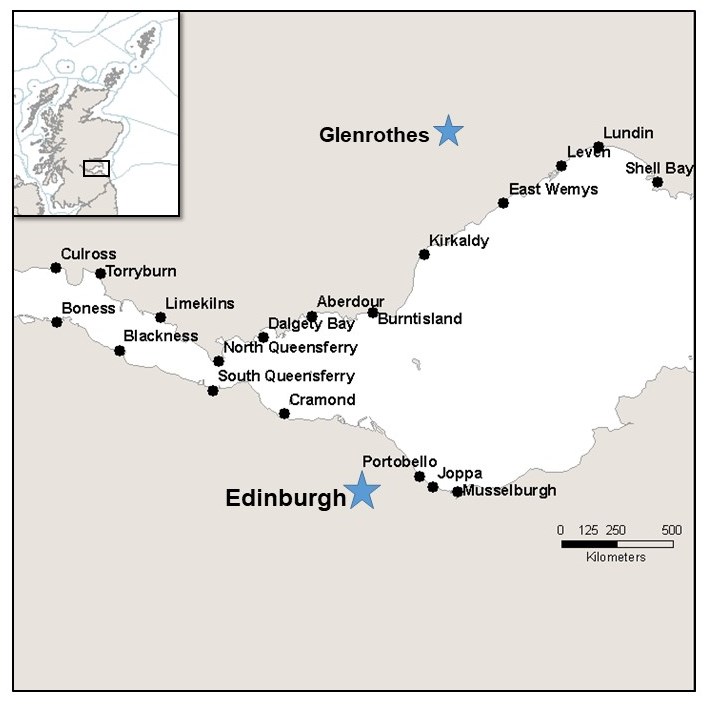Plastic litter is ubiquitous in the marine environment. Larger items are very visible and the consequences of impacts on charismatic megafauna have caught the public imagination, leading to several government policies aimed at reducing consumption of single-use plastic items.
However, microplastics (100 µm – 5 mm), although featuring in the environment as, for example, nurdles (pieces of plastic less than 5 mm in size manufactured as the raw material to make bigger plastic items) or cosmetic beads, have received less public attention. They are invisible to the casual observer, swimming or walking along a beach, and require often labour-intensive extraction procedures and specialized equipment, not normally available to the general public.
Any policy measure leading to regulatory legislation needs a periodic performance appraisal and baseline data against which to benchmark. Between 2014-2018, Heriot-Watt University, the St Abbs Marine Station and the Orkney Island Council have been collaborating to generate a baseline database for microplastics in the Scottish intertidal environment.
The main focus has been on the Firth of Forth, where 19 sites around the coast were sampled for sediment by Heriot-Watt (Figure 1). At each site 3 stations were sampled in triplicate (total of 9 samples per site with results averaged to give a mean value for each site).
More recently (2018), this work has been extended to Orkney and the Berwickshire coast, where sampling was carried out by the Orkney Island Council and the St. Abbs Marine Station respectively. The analysis of these samples is still in progress and only data from the Firth of Forth are presented here.
The method used to extract microplastics from sediments and polymer identification has been published in the peer-reviewed literature (Blumenröder, Sechet, Kakkonen, & Hartl, 2017).
The microplastic concentrations in Firth of Forth sediment varied considerably from year to year (30-440 particles kg-1 dry weight (DW); 1,723-5,831 fibres kg-1 DW) and showed no significant changes from 2014 to 2018 (Table 1). Predominant polymers were various types of polyethylene, particularly polyester fibres. However, as it would be impractical to attempt to analyse every extracted microplastic particle and fibre, only a subsample of representative material was analysed.
Adherence to the extraction protocol and strict contamination mitigation measures suggest that the high variability is largely a reflection of the dynamic nature of the sediment, and that more regular sampling is required to increase the resolution. Data from environmental studies are notoriously variable and therefore, in the absence of existing long-term datasets, repeated sampling (to capture temporal variability, seasonality etc.) is considered necessary to fully understand this variability. If funding permits, the next step would be monthly sampling at fewer sites. Given that the variability was not significant, i.e. there was no real increase or decrease over the 5 year sampling period), we can consider that the available data to date are a starting point in providing a first baseline of the actual levels of such materials in the inter tidal sediments around the coast against which future levels can be compared.
|
Particles
|
Fibres
|
|||
|
|
kg-1 DW
|
SD
|
kg-1 DW
|
SD
|
|
May-14
|
70
|
51
|
1,723
|
1,633
|
|
Sept-15
|
-
|
-
|
4,302
|
2,292
|
|
May-16
|
440
|
148
|
2,248
|
721
|
|
Sep-16
|
100
|
80
|
2,529
|
2,080
|
|
May-17
|
30
|
30
|
2,633
|
966
|
|
Sep-17
|
70
|
105
|
5,831
|
2107
|
|
Sep-18
|
97
|
105
|
3,530
|
690
|

Marine litter is the collective term for ‘any persistent manufactured or processed solid material discarded, disposed of or abandoned in the marine and coastal environments, including material lost at sea in bad weather’.
Marine litter is found everywhere in the world’s oceans, not only close to densely populated areas but also in remote areas far from obvious sources. The main land based sources are tourism, fly tipping, sewage, and waste disposal sites and the litter can be transported to the sea by rivers, drainage systems, sewage run-off or the wind. The main sea based sources are shipping, fishing and offshore oil and gas installations.
Significant quantities of marine litter appear in the seas and on beaches. Litter is unsightly and can cause harm to marine wildlife through entanglement and ingestion, smothering of the seabed and as a platform for invasive species. Plastics are the main type of litter found both on beaches and offshore, including increasing quantities of microplastic resulting from degradation of larger plastic products in the sea or the direct release of microplastics.
Marine litter was assessed by looking at microplastics in surface water, beach litter using the pilot Scottish Beach Litter Performance Indicators and sea-floor litter using data gathered by the International Bottom Trawl Surveys.

Links and resources
|
, 2017. Microplastic contamination of intertidal sediments of Scapa Flow, Orkney: A first assessment. Marine Pollution Bulletin, 124(1), pp.112 - 120. Available at: http://www.sciencedirect.com/science/article/pii/S0025326X17305908. |

